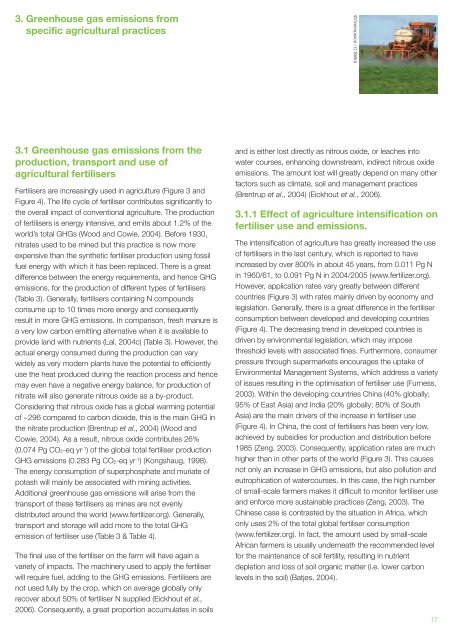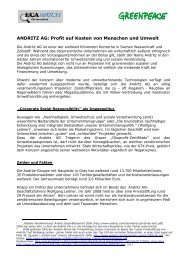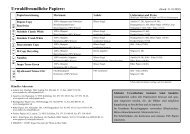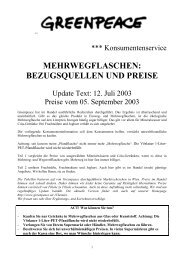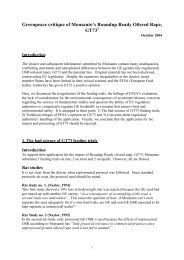Cool Farming: Climate impacts of agriculture and mitigation potential
Cool Farming: Climate impacts of agriculture and mitigation potential
Cool Farming: Climate impacts of agriculture and mitigation potential
You also want an ePaper? Increase the reach of your titles
YUMPU automatically turns print PDFs into web optimized ePapers that Google loves.
3. Greenhouse gas emissions from<br />
specific agricultural practices<br />
3.1 Greenhouse gas emissions from the<br />
production, transport <strong>and</strong> use <strong>of</strong><br />
agricultural fertilisers<br />
Fertilisers are increasingly used in <strong>agriculture</strong> (Figure 3 <strong>and</strong><br />
Figure 4). The life cycle <strong>of</strong> fertiliser contributes significantly to<br />
the overall impact <strong>of</strong> conventional <strong>agriculture</strong>. The production<br />
<strong>of</strong> fertilisers is energy intensive, <strong>and</strong> emits about 1.2% <strong>of</strong> the<br />
world’s total GHGs (Wood <strong>and</strong> Cowie, 2004). Before 1930,<br />
nitrates used to be mined but this practice is now more<br />
expensive than the synthetic fertiliser production using fossil<br />
fuel energy with which it has been replaced. There is a great<br />
difference between the energy requirements, <strong>and</strong> hence GHG<br />
emissions, for the production <strong>of</strong> different types <strong>of</strong> fertilisers<br />
(Table 3). Generally, fertilisers containing N compounds<br />
consume up to 10 times more energy <strong>and</strong> consequently<br />
result in more GHG emissions. In comparison, fresh manure is<br />
a very low carbon emitting alternative when it is available to<br />
provide l<strong>and</strong> with nutrients (Lal, 2004c) (Table 3). However, the<br />
actual energy consumed during the production can vary<br />
widely as very modern plants have the <strong>potential</strong> to efficiently<br />
use the heat produced during the reaction process <strong>and</strong> hence<br />
may even have a negative energy balance, for production <strong>of</strong><br />
nitrate will also generate nitrous oxide as a by-product.<br />
Considering that nitrous oxide has a global warming <strong>potential</strong><br />
<strong>of</strong> ~296 compared to carbon dioxide, this is the main GHG in<br />
the nitrate production (Brentrup et al., 2004) (Wood <strong>and</strong><br />
Cowie, 2004). As a result, nitrous oxide contributes 26%<br />
(0.074 Pg CO2-eq yr -1 ) <strong>of</strong> the global total fertiliser production<br />
GHG emissions (0.283 Pg CO2-eq yr -1 ) (Kongshaug, 1998).<br />
The energy consumption <strong>of</strong> superphosphate <strong>and</strong> muriate <strong>of</strong><br />
potash will mainly be associated with mining activities.<br />
Additional greenhouse gas emissions will arise from the<br />
transport <strong>of</strong> these fertilisers as mines are not evenly<br />
distributed around the world (www.fertilizer.org). Generally,<br />
transport <strong>and</strong> storage will add more to the total GHG<br />
emission <strong>of</strong> fertiliser use (Table 3 & Table 4).<br />
The final use <strong>of</strong> the fertiliser on the farm will have again a<br />
variety <strong>of</strong> <strong>impacts</strong>. The machinery used to apply the fertiliser<br />
will require fuel, adding to the GHG emissions. Fertilisers are<br />
not used fully by the crop, which on average globally only<br />
recover about 50% <strong>of</strong> fertiliser N supplied (Eickhout et al.,<br />
2006). Consequently, a great proportion accumulates in soils<br />
<strong>and</strong> is either lost directly as nitrous oxide, or leaches into<br />
water courses, enhancing downstream, indirect nitrous oxide<br />
emissions. The amount lost will greatly depend on many other<br />
factors such as climate, soil <strong>and</strong> management practices<br />
(Brentrup et al., 2004) (Eickhout et al., 2006).<br />
3.1.1 Effect <strong>of</strong> <strong>agriculture</strong> intensification on<br />
fertiliser use <strong>and</strong> emissions.<br />
The intensification <strong>of</strong> <strong>agriculture</strong> has greatly increased the use<br />
<strong>of</strong> fertilisers in the last century, which is reported to have<br />
increased by over 800% in about 45 years, from 0.011 Pg N<br />
in 1960/61, to 0.091 Pg N in 2004/2005 (www.fertilizer.org).<br />
However, application rates vary greatly between different<br />
countries (Figure 3) with rates mainly driven by economy <strong>and</strong><br />
legislation. Generally, there is a great difference in the fertiliser<br />
consumption between developed <strong>and</strong> developing countries<br />
(Figure 4). The decreasing trend in developed countries is<br />
driven by environmental legislation, which may impose<br />
threshold levels with associated fines. Furthermore, consumer<br />
pressure through supermarkets encourages the uptake <strong>of</strong><br />
Environmental Management Systems, which address a variety<br />
<strong>of</strong> issues resulting in the optimisation <strong>of</strong> fertiliser use (Furness,<br />
2003). Within the developing countries China (40% globally;<br />
95% <strong>of</strong> East Asia) <strong>and</strong> India (20% globally; 80% <strong>of</strong> South<br />
Asia) are the main drivers <strong>of</strong> the increase in fertiliser use<br />
(Figure 4). In China, the cost <strong>of</strong> fertilisers has been very low,<br />
achieved by subsidies for production <strong>and</strong> distribution before<br />
1985 (Zeng, 2003). Consequently, application rates are much<br />
higher than in other parts <strong>of</strong> the world (Figure 3). This causes<br />
not only an increase in GHG emissions, but also pollution <strong>and</strong><br />
eutrophication <strong>of</strong> watercourses. In this case, the high number<br />
<strong>of</strong> small-scale farmers makes it difficult to monitor fertiliser use<br />
<strong>and</strong> enforce more sustainable practices (Zeng, 2003). The<br />
Chinese case is contrasted by the situation in Africa, which<br />
only uses 2% <strong>of</strong> the total global fertiliser consumption<br />
(www.fertilizer.org). In fact, the amount used by small-scale<br />
African farmers is usually underneath the recommended level<br />
for the maintenance <strong>of</strong> soil fertility, resulting in nutrient<br />
depletion <strong>and</strong> loss <strong>of</strong> soil organic matter (i.e. lower carbon<br />
levels in the soil) (Batjes, 2004).<br />
©Greenpeace / D Beltrá<br />
17


